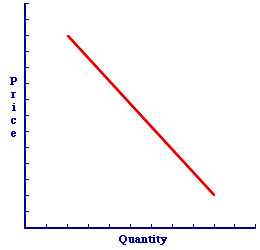
|
|
FCC: The abbreviation for the Federal Communications Commission, which was established by the Communications Act of 1934 and is charged with regulating interstate and international communications by radio, television, wire, satellite and cable. The FCC consists of five Commissioners appointed by the President and confirmed by the Senate. Each commissioner serves a 5-year term, except when filling an unexpired term. One of the regulatory forces in the marketing environment.
Visit the GLOSS*arama
|
|


|

|
                           NUMBER OF BUYERS, DEMAND DETERMINANT: The number of buyers willing and able to buy a good, which is assumed constant when a demand curve is constructed. The number of buyers is one of five demand determinants that shift the demand curve when they change. The other four are buyers' income, buyers' preferences, other prices, and buyers' expectations. The number of buyers willing and able to buy a good affects the overall demand. The relation is relatively straightforward. With more buyers, there is more demand. With fewer buyers, there is less demand.All in the NumbersThe overall market demand of a good is based on the combination of the demands by each buyer. If five buyers are each willing and able to buy 100 units of a good, at the going market price, then the total market demand is 500 units. If a sixth buyer should enter the market, also willing and able to buy 100 units, then the total market demand increases to 600 units. If one of the five original buyers should leave the market, then the total market demand decreases to 400 units. With more buyers, there is a greater demand. With fewer buyers, there is less demand.Shifting the Demand Curve| Number of Buyers |  |
A change in the number of buyers causes the demand curve to shift. This can be illustrated using the negatively-sloped demand curve for Wacky Willy Stuffed Amigos presented in this exhibit. This demand curve captures the specific one-to-one, law of demand relation between demand price and quantity demanded. The number of buyers is assumed to remain constant with the construction of this demand curve.Now, consider how a change in the number of buyers shifts the demand curve. - More Buyers: If there is an increase in the number of buyers in the market, then the demand for the good increases. It is just that simple. This is seen as a rightward shift of the demand curve. Click the [More Buyers] button to demonstrate.
- Fewer Buyers: If there is a decrease in the number of buyers in the market, then the demand for the good decreases. Which is also straightforward. This is seen as a leftward shift of the demand curve. Click the [Fewer Buyers] button to demonstrate.
By the NumbersThe important role that the number of buyers determinant plays in a market is well recognized in the business world. Many businesses are occupied, day and night, with ways to increase the number of buyers for their own particular slice of the market. For example, advertising is designed, in part, to increase the number of buyers in a particular market or for a particular good.The number of participants on the buying side of the market is also important when it comes to competition and market control. Market control depends on the number of competitors. Fewer competitors means more market control for each. More competitors means less market control for each. A given buyer, in general, would rather have fewer participants on the buying side, which would then give it greater market control. Good for the buyer. Of course, fewer competitors and greater market control also means less efficiency. Bad for the economy.

Recommended Citation:NUMBER OF BUYERS, DEMAND DETERMINANT, AmosWEB Encyclonomic WEB*pedia, http://www.AmosWEB.com, AmosWEB LLC, 2000-2025. [Accessed: July 18, 2025].
Check Out These Related Terms... | | | | | | |
Or For A Little Background... | | | | | | | | | | | |
And For Further Study... | | | | | | |
Search Again?
Back to the WEB*pedia
|



|

|
RED AGGRESSERINE
[What's This?]
Today, you are likely to spend a great deal of time at a flea market wanting to buy either a weathervane with a cow on top or a box of multi-colored, plastic paper clips. Be on the lookout for telephone calls from long-lost relatives.
Your Complete Scope
This isn't me! What am I?
|

|
|
In the late 1800s and early 1900s, almost 2 million children were employed as factory workers.
|

|
|
"A winner is someone who recognizes his God-given talents, works his tail off to develop them into skills, and uses those skills to accomplish his goals. " -- Larry Bird, basketball player
|

|
IO
Industrial Organization
|

|
|
Tell us what you think about AmosWEB. Like what you see? Have suggestions for improvements? Let us know. Click the User Feedback link.
User Feedback
|


|


